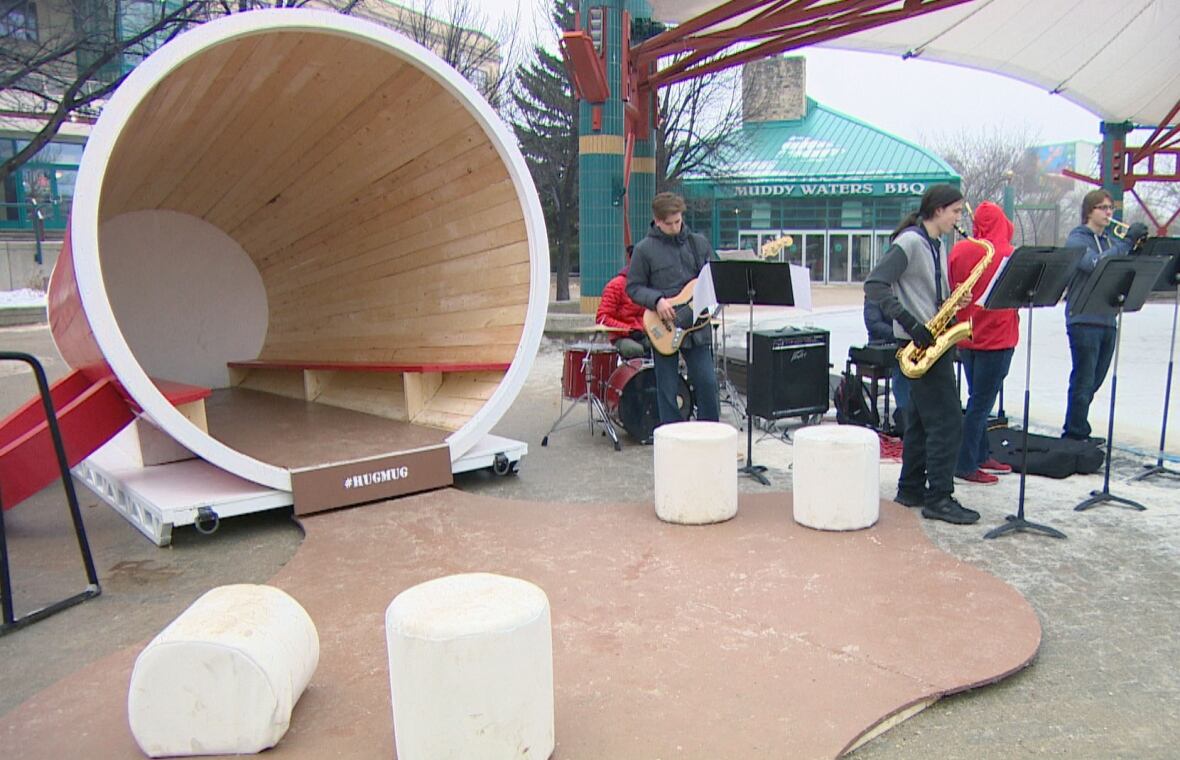'Level of creativity is outstanding' for 2018 warming huts: Forks
A bison, temple performance space, and mug of hot chocolate with marshmallow benches are among new designs
Winnipeg's river trail will be loaded with new art and architecture next week, as construction on the latest warming huts nears completion.
This year's annual open competition to design huts for skaters and other users of the river trail attracted a record number of submissions — nearly 180 — from local, national and international artists and architecture groups, according to Paul Jordan, CEO of The Forks Renewal Corporation.

"The warming huts competition continues to gain traction on an international level and bring fantastic art and architecture to Winnipeg," he said.
"The level of creativity is outstanding [and] this year's selections are extremely representative of this environment at The Forks — a bison, a giant lookout tower which really highlights the vast, Prairie landscape, and a big tree trunk reminiscent of the driftwood and logs we see floating down the river as it melts each spring."
Internationally known Winnipeg filmmaker Guy Maddin, currently a visiting lecturer at Harvard University, is this year's invited guest designer.
As well, for the eighth year, the University of Manitoba's faculty of architecture has an entry, called Pontagon, while students from Mennonite Brethren Collegiate Institute also constructed one, called Hug Mug.
Pontagon, the faculty explained, is a group of five structures and an "ice plaza" that links the two sides of the Assiniboine river.
"For the 2018 edition of warming huts, the faculty of architecture collaborated with the City of Winnipeg on the design process of a new pedestrian and cycling bridge, connecting Osborne Village to the downtown," the entry states.

"Pontagon will contribute to the research and consultation process by posing the question: 'What is in a bridge?' The project will assist the development of the bridge design in helping to bring the community together to imagine the bridge as a 'future memory' of what it will become."
Jonathan Beddoes, dean of the faculty, said the group is thrilled to be part of the competition again.
"We believe that the opportunity provided to our students by being part of this design-build collaboration provides a highly unique educational experience," he said.

"This type of experiential education enhances what is taught in the classroom, and we are thankful to The Forks for allowing us to be part of this exciting event."
Hug Mug — a hut in the shape of a giant mug, complete with marshmallows serving as benches — is "an invitation to celebrate the moments of our lives with those around us, as well as the hope that what we have will spill over in abundance to those in need," the entry states.


The huts will be completed and taken down to their homes on the Red River Mutual Trail by early next week, where they will join 2017 winners Open Border and Greetings from Bubble Beach, and past winners Hygge House, Smokehouse, Skybox, Fir Hut, Apparition, Red Blanket, Windshield, Recycling Words and The Hole Idea.
Maddin's piece, Temple of Lost Things, is located under the spans of the Norwood Bridge and features several "memory" columns made of ice, supporting a mesh screen where projection art and performances will take place.
It will all be surrounded by benches sculpted from ice harvested from the river.
"This Temple of Lost Things is about the ephemerality of the world in which we all live — our own ephemerality," Maddin told CBC News about the project, which also features driftwood found on the banks of the Assiniboine River.
"Come spring the ice we're standing on will melt, the ice the thing is made out of will melt, and the wood will float down the river and end up on the banks of the river once again. Everything will just go away and something else will come again next year here."

The netting, Maddin said, gives the shelter a ghostly appearance while its location under the bridge provides "great acoustics."
The hut will host a choral event early next month, he said, adding "It's going to be really striking."
Maddin worked with local architect Peter Hargraves to finish the design and the pair brought in Luca Roncoroni, an ice-sculptor and architect from Norway to help bring it to life.
Roncoroni has been taking part in the annual warming hut art and architecture competition at The Forks since 2012 and says the use of river ice has grown in popularity since that first time, when he cut out small blocks using chainsaws.

"Now we've developed machines and saws and techniques that allow us to pick up blocks that are, like, one ton that have been harvested right here on the Red River," he said.
"It's beautiful ice that we can harvest and use 100 per cent locally, so it's been a tremendous improvement from five or six years ago."

Maddin said it's an honour to be a part of the competition.
"This is such an amazing event and to be involved in it, and at a high-profile level. I feel like I've sneaked in through the back door of yet another field of work," he said.
"Guaranteed I put this on my CV. I may need the credit sometime — I might be teaching warming-hut making at some college somewhere in the future."
With files from Jaison Empson
